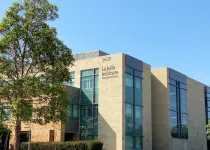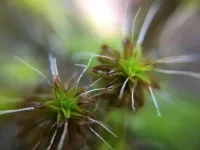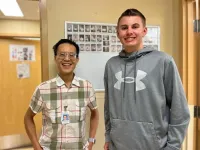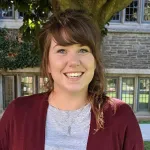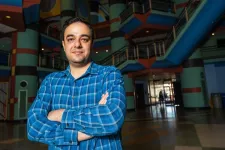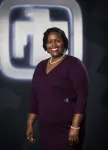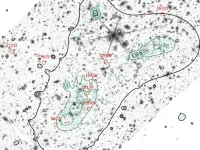(Press-News.org) RIVERSIDE, Calif. -- For centuries, coronaviruses have triggered health crises and economic challenges, with SARS-CoV-2, the coronavirus that spreads COVID-19, being a recent example. One small protein in SARS-CoV-2, the Membrane protein, or M protein, is the most abundant and plays a crucial role in how the virus acquires its spherical structure. Nonetheless, this protein’s properties are not well understood.
A research team led by a physicist at the University of California, Riverside, has devised a new method to make large quantities of M protein, and has characterized the protein’s physical interactions with the membrane — the envelope, or “skin,” — of the virus. The team’s theoretical modeling and simulations show how these interactions are likely contributing to the virus assembling itself.
The researchers report in their paper published today in Science Advances that when the M protein, which is adjacent to the spike protein on SARS-CoV-2, gets lodged in the membrane, it coaxes the membrane to curve by locally reducing the membrane thickness. This induction of curvature leads to SARS-CoV-2’s spherical shape.
“If we can better understand how the virus assembles itself, then, in principle, we can come up with ways to stop that process and control the virus’ spread,” said Thomas E. Kuhlman, an assistant professor of physics and astronomy, who led the research project. “M protein has previously resisted any kind of characterization because it is so hard to make.”
Kuhlman and his colleagues overcame this difficulty by using Escherichia coli bacteria as a “factory” to make the M protein in large numbers. Kuhlman explained that although E. coli can make copious amounts of M proteins, the proteins tend to clump together in the E. coli cells, eventually killing them. To circumvent this challenge, the researchers induced the E. coli cells to produce the protein Small Ubiquitin-related Modifier, or SUMO, along with the M protein.
“In our experiments, when E. coli makes M protein, it makes SUMO at the same time,” Kuhlman said. “The M protein fuses with the SUMO protein, which prevents the M proteins from sticking to one another. The SUMO protein is relatively easy to remove via another protein that simply cuts it off. The M protein is thus purified and separated from SUMO.”
The work provides fundamental insights into the mechanisms driving SARS-CoV-2 viral assembly.
“As M proteins are an integral component of other coronaviruses as well, our findings provide useful insights that can enhance our understanding and potentially enable interventions in viral formation not only in SARS-CoV-2 but also in other pathogenic coronaviruses,” Kuhlman said.
Next, the researchers plan to study the interactions of the M protein with other SARS-CoV-2 proteins to potentially disrupt these interactions with drugs.
Kuhlman was joined in the research by fellow-UCR physicists Roya Zandi and Umar Mohideen. Kuhlman was charged with making the M proteins. Mohideen, a distinguished professor of physics and astronomy, used atomic force microscopy and cryogenic electron microscopy to measure how the M protein interacts with the membrane. Zandi, an expert on virus assembly and a professor of physics and astronomy, developed simulations of how the M proteins interact with each other and with the membrane.
Other coauthors on the paper are Yuanzhong Zhang, Siyu Li, Michael Worcester, Sara Anbir, Joseph McTiernan, Pratyasha Mishra, and Ajay Gopinathan of UCR; and Michael E. Colvin of UC Merced. Co-first authors Zhang and Anbir contributed equally to the work.
The research was supported by a grant from the University of California Office of the President to investigate how the COVID-19 virus assembles itself.
The research paper is titled “Synthesis, Insertion, and Characterization of SARS-CoV-2 Membrane Protein Within Lipid Bilayers.”
The University of California, Riverside is a doctoral research university, a living laboratory for groundbreaking exploration of issues critical to Inland Southern California, the state and communities around the world. Reflecting California's diverse culture, UCR's enrollment is more than 26,000 students. The campus opened a medical school in 2013 and has reached the heart of the Coachella Valley by way of the UCR Palm Desert Center. The campus has an annual impact of more than $2.7 billion on the U.S. economy. To learn more, visit www.ucr.edu.
END
How the SARS-CoV-2 virus acquires its spherical shape
UC Riverside-led study findings can help tackle other pathogenic coronaviruses
2024-02-28
ELSE PRESS RELEASES FROM THIS DATE:
A step toward personalized immunotherapy for all
2024-02-28
LA JOLLA, CA—Most cancers are thought to evade the immune system. These cancers don't carry very many mutations, and they aren’t infiltrated by cancer-fighting immune cells. Scientists call these cancers immunologically "cold."
Now new research suggests such cancers aren't as "cold" as once thought. Researchers from the La Jolla Institute for Immunology (LJI), UC San Diego Moores Cancer Center, and UC San Diego, have found that patients with "cold" tumors actually do make cancer-fighting T cells.
This discovery opens the door to developing vaccines or therapies to increase T cell ...
Drying without dying: Tracing water scarcity coping mechanisms from mosses to flowering plants
2024-02-28
Imagine: You find the dried-up remains of a once green and lush philodendron on your bookshelf and realize you can’t remember the last time you watered your houseplants. You soak the soil with water, hoping you can breathe life back into its desiccated husk, but it is futile. The plant has been too dehydrated for too long, and irreparable damage has been done.
Now imagine that it isn’t your neglected houseplants that have been subjected to an unexpectedly dry growing season, but a field of wheat. With changes in global climate, such things are becoming more common and more of a concern for farmers, consumers, and researchers alike as the threat to food security intensifies.
But ...
Study finds drought fuels invasive species after wildfires
2024-02-28
Irvine, Calif., Feb. 28, 2024 — In a study recently published in the journal Ecology, University of California, Irvine scientists uncover the intricate dance between drought, wildfires and invasive species in Southern California's coastal sage scrub ecosystems.
Titled “Long-term drought promotes invasive species by reducing wildfire severity,” the research, led by Sarah Kimball, Ph.D., director of the Center for Environmental Biology at UCI, sheds light on the critical interplay of these factors and its ...
A safer treatment path for high-risk children to overcome food allergies
2024-02-28
New research from the University of British Columbia reveals a safe path to overcoming food allergies for older children and others who can’t risk consuming allergens orally to build up their resistance.
It’s called sublingual immunotherapy (SLIT), and it involves placing smaller amounts of food allergens under the tongue.
A study conducted by UBC clinical professor and pediatric allergist Dr. Edmond Chan and his team at BC Children’s Hospital Research Institute found SLIT to be as safe and effective for high-risk older children and adolescents ...
Researchers create method to detect cases of anemia in archaeological remains
2024-02-28
Hamilton, ON, Feb. 28, 2024 – Diagnosing anemia in living people is typically a matter of a routine blood test.
Retrospectively diagnosing anemia in people who died decades or even centuries ago is much more challenging since there is no blood left to test.
Anthropologists at McMaster University and the University of Montreal, working with a hematologist colleague, have overcome that obstacle by developing a way to detect anemia through patterns in the structures of bones.
Paleopathologists Megan Brickley, ...
Data-processing tool could enable better early stage cancer detection
2024-02-28
Cancers begin with abnormal changes in individual cells, and the ability to track the accumulation of mutations at the single-cell level can shed new light on the early stages of the disease. Such knowledge could enable more effective early detection and treatment options for patients as well as more accurate predictions of disease progression.
According to a paper in Nature Communications, a team of Rice University researchers led by Luay Nakhleh has developed a platform for integrating DNA and RNA data from single-cell sequencing with greater speed and precision than more recent, state-of-the-art technologies. The method, mapping cross domain ...
ESA 2024 Graduate Student Policy Award Cohort named
2024-02-28
The Ecological Society of America is pleased to announce the recipients of the 2024 Katherine S. McCarter Graduate Student Policy Award (GSPA). Students in the 2024 cohort are engaged in advocacy with an interest in science policy. Awardees will travel to Washington, D.C., for policy, communication and career training followed by meetings with lawmakers on Capitol Hill.
“I am thrilled to welcome this latest cohort of Graduate Student Policy Awardees,” said ESA President Shahid Naeem. “The caliber of this year's awardees, as has been true for awardees in our program since its inception, reflects ...
Five Sandia Labs scientists earn 2024 Black Engineer of the Year Awards
2024-02-28
Dissecting doorbells, exploring music, mastering retail software, love of the arts and old-fashioned hard work were early paths that led five Sandia National Laboratories engineers to their callings and recently earned them national Black Engineer of the Year Awards.
The awards, recognizing outstanding achievements in engineering, science and technology, include Science Spectrum Trailblazer, Modern Day Technology Leader, Most Promising Engineer in Industry and the Senior Investigator Award.
Each Sandia award winner has made significant contributions in creative, innovative and science-based systems engineering solutions to help solve our nation’s most challenging national security ...
'Cosmic lighthouses' that cleared primordial fog identified with JWST
2024-02-28
UNIVERSITY PARK, Pa. — Scientists working with data from NASA's James Webb Space Telescope (JWST) have obtained the first full spectra of some of the earliest starlight in the universe. The images provide the clearest picture yet of very low-mass, newborn galaxies, created less than a billion years after the Big Bang, and suggest the tiny galaxies are central to the cosmic origin story.
The international team of researchers, including two Penn State astrophysicists, published their results ...
Avian influenza virus is adapting to spread to marine mammals
2024-02-28
The highly pathogenic avian influenza virus H5N1 has adapted to spread between birds and marine mammals, posing an immediate threat to wildlife conservation, according to a study from the University of California, Davis, and the National Institute of Agricultural Technology (INTA) in Argentina.
The study, published in the journal Emerging Infectious Diseases, is the first genomic characterization of H5N1 in marine wildlife on the Atlantic shore of South America.
For the study, scientists collected brain samples from four sea lions, one fur seal and a tern found dead at the most affected sea lion rookery in Argentina. All ...
LAST 30 PRESS RELEASES:
Norbert Holtkamp appointed director of Fermi National Accelerator Laboratory
New agentic AI platform accelerates advanced optics design
Biologists discover neurons use physical signals — not electricity — to stabilize communication
Researchers discover that a hormone can access the brain by hitchhiking
University of Oklahoma researcher awarded funding to pursue AI-powered material design
Exploring how the visual system recovers following injury
Support for parents with infants at pediatric check-ups leads to better reading and math skills in elementary school
Kids’ behavioral health is a growing share of family health costs
Day & night: Cancer disrupts the brain’s natural rhythm
COVID-19 vaccination significantly reduces risk to pregnant women and baby
The role of vaccination in maternal and perinatal outcomes associated with COVID-19 in pregnancy
Mayo Clinic smartwatch system helps parents shorten and defuse children's severe tantrums early
Behavioral health spending spikes to 40% of all children’s health expenditures, nearly doubling in a decade
Digital cognitive behavioral treatment for generalized anxiety disorder
Expenditures for pediatric behavioral health care over time and estimated family financial burden
Air conditioning in nursing homes and mortality during extreme heat
The Alps to lose a record number of glaciers in the next decade
What makes a good proton conductor?
New science reporting guide published for journalists in Bulgaria
New international study reveals major survival gaps among children with cancer
New science reporting guide published for journalists in Turkey
Scientists develop a smarter mRNA therapy that knows which cells to target
Neuroanatomy-informed brain–machine hybrid intelligence for robust acoustic target detection
Eight SwRI hydrogen projects funded by ENERGYWERX
The Lundquist Institute and its start-up company Vitalex Biosciences Announces Strategic Advancement of Second-Generation fungal Vaccine VXV-01 through Phase 1 Trials under $40 Million Competitive Con
Fine particles in pollution are associated with early signs of autoimmune disease
Review article | Towards a Global Ground-Based Earth Observatory (GGBEO): Leveraging existing systems and networks
Penn and UMich create world’s smallest programmable, autonomous robots
Cleveland researchers launch first major study to address ‘hidden performance killer’ in athletes
To connect across politics, try saying what you oppose
[Press-News.org] How the SARS-CoV-2 virus acquires its spherical shapeUC Riverside-led study findings can help tackle other pathogenic coronaviruses

